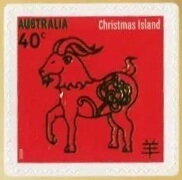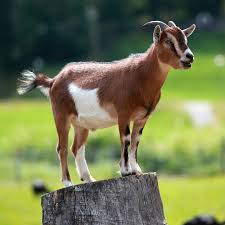Stamp: Goat (Christmas Island 2024)
Goat (Christmas Island 2024)
29 January (Christmas Island ) within release Year of the Dragon 2024 goes into circulation Stamp Goat face value 40 Australian cent
| Stamp Goat in catalogues | |
|---|---|
| Colnect codes: | Col: CX 2024.01.29-05e |
Stamp is square format.
Stamp from round mini sheet.Also in the issue Year of the Dragon 2024:
- Stamp - Bull face value 1;
- Stamp - Chinese Inscription face value 8;
- Stamp - Dog face value 80;
- Stamp - Dog face value 80;
- Stamp - Dragon face value 1;
- Stamp - Dragon face value 1;
- Stamp - Goat face value 40;
- Stamp - Goat face value 40;
- Stamp - Horse face value 20;
- Stamp - Horse face value 20;
- Stamp - Monkey face value 1;
- Stamp - Monkey face value 1;
- Stamp - Ox face value 1;
- Stamp - Pig face value 20;
- Stamp - Pig face value 20;
- Stamp - Rabbit face value 20;
- Stamp - Rabbit face value 20;
- Stamp - Rat face value 80;
- Stamp - Rat face value 80;
- Stamp - Rooster face value 40;
- Stamp - Rooster face value 40;
- Stamp - Snake face value 80;
- Stamp - Snake face value 80;
- Stamp - Tiger face value 40;
- Stamp - Tiger face value 40;
- Stamp - Year of the Dragon 2024 face value 1.20;
- Stamp - Year of the Dragon 2024 face value 2.40;
- Stamp - Year of the Dragon 2024 face value 3.60;
- Souvenir Sheet - Year of the Dragon 2024 face value 7.20;
- Mini Sheet - Year of the Dragon 2024 Calendar Sheet face value 17.60;
- Souvenir Sheet - Year of the Dragon 2024 Zodiac Sheet face value 16.80;
- Booklet - Year of the Dragon Prestige Booklet face value 33.60;
- Booklet Pane - Year of the Dragon Prestige Booklet face value 4*1.20;
- Booklet Pane - Year of the Dragon Prestige Booklet face value 7.20;
- Booklet Pane - Year of the Dragon Prestige Booklet face value 7.20;
- Booklet Pane - Year of the Dragon Prestige Booklet face value 9.60;
- Booklet Pane - Year of the Dragon Prestige Booklet face value 4*1.20;
Stamp Goat it reflects the thematic directions:
Animals are multicellular, eukaryotic organisms of the kingdom Animalia (also called Metazoa). All animals are motile, meaning they can move spontaneously and independently, at some point in their lives. Their body plan eventually becomes fixed as they develop, although some undergo a process of metamorphosis later on in their lives. All animals are heterotrophs: they must ingest other organisms or their products for sustenance.
Chinese New Year or the Spring Festival (see also § Names) is a festival that celebrates the beginning of a new year on the traditional lunisolar Chinese calendar. Marking the end of winter and the beginning of spring, observances traditionally take place from Chinese New Year's Eve, the evening preceding the first day of the year, to the Lantern Festival, held on the 15th day of the year. The first day of Chinese New Year begins on the new moon that appears between 21 January and 20 February
The goat or domestic goat (Capra hircus) is a species of domesticated goat-antelope that is mostly kept as livestock. It was domesticated from the bezoar ibex (C. aegagrus aegagrus) of Southwest Asia and Eastern Europe. The goat is a member of the family Bovidae, meaning it is closely related to the sheep. There are over 300 distinct breeds of goat. It is one of the oldest domesticated species of animal - according to archaeological evidence its earliest domestication occurred in Iran at 10,000 calibrated calendar years ago
The zodiac is a belt-shaped region of the sky that extends approximately 8° north and south (as measured in celestial latitude) of the ecliptic, the apparent path of the Sun across the celestial sphere over the course of the year. Also within this zodiac belt appear the Moon and the brightest planets, along their orbital planes. The zodiac is divided along the ecliptic into 12 equal parts ("signs"), each occupying 30° of celestial longitude. These signs roughly correspond to the astronomical constellations with the following modern names: Aries, Taurus, Gemini, Cancer, Leo, Virgo, Libra, Scorpio, Sagittarius, Capricorn, Aquarius, and Pisces.






